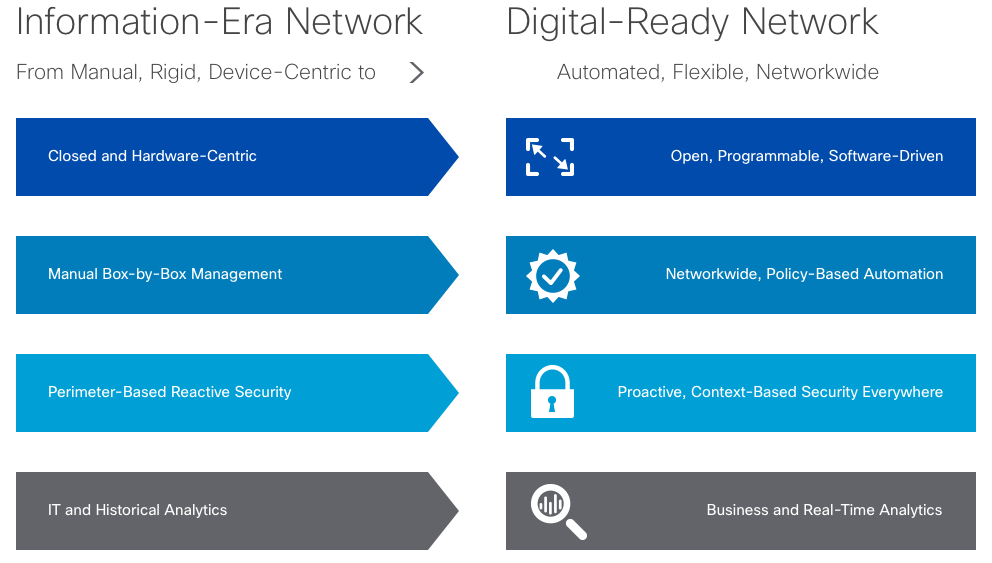Part II: The Role of the Network Must Expand for Digital Transformation
As we move into the Digital Era, organizations seeking to make a digital transformation must also make a network transformation. In my previous blog, I highlighted that it is the network that brings together all things digital. And as we leave the Information Era and enter the Digital Era (See Diagram I below), we must evolve the network to move beyond connectivity to a platform of Insights, Automation and Security. In this blog, I dive in deeper into each area to discuss the opportunity for IT.

Diagram I: Network Evolution for the Digital Era
Insights. The network touches all things digital – users, devices, applications, sensors and cloud – and is in a unique position to capture insights in real time that allows businesses to make better decisions instantly and deliver better experiences. For example, there are organizations today that leverage location data from the network to better engage their customers or better serve their workforce. They use location data for a broad set of use cases including:
- Measuring the impact of a promotion for storefront conversion.
- Optimizing HVAC systems to lower costs and reduce carbon footprint.
- Churning hospital beds faster to more quickly admit patients in need of critical care.
- Monitoring expensive machinery and equipment and using analytics to pre-determine the service level to maintain safety standards.
- Collecting enterprise real estate usage patterns to optimize floor plans or lower leasing costs.
These are all examples of business innovation through network intelligence or analytics. To do this effectively, IT professions will need to partner with their business leaders to explore opportunities for their organization. This means learning the language of business executives, and translating the technical possibilities into business results. (Check out this guide on the business value of mobility. Registration required.)
Automation. This area is centered on IT speed and simplicity. Today’s networking professionals are CLI jockeys, but that will offer less value as time goes on. The network is evolving to software with open APIs, Software-Defined Networking (SDN), Network Functions Virtualization (NFV) and more. Cisco’s new architecture is leading this effort with the evolved Cisco IOS XE, an open operating system that is programmable, service extensible and virtualized through model-driven APIs, application containers and Enterprise Network Functions Virtualization (Enterprise NFV).
The great news for IT is that we are fully abstracting the network complexity and allowing networking professionals to automate all processes. This will free up cycles for IT to focus on innovation. We’re also virtualizing 30 years of networking innovation by decoupling hardware from software and bringing more speed and agility to networking – much like what the data center has been driving over the past 10 years.
This change also means IT needs to evolve their skills set for the future. IT will need to better understand the rich intelligence the network offers to more efficiently run the network and determine how to build competitive advantage for the business. That means networking professionals need to expand their skills in new areas and become more business savvy. We recognize the responsibility Cisco has to take our professional community forward and have already taken measures in our certification programs. Additionally, we are aggressively investing in our DevNet developer program so that partners, ISVs and customers can take full advantage of the open platform Cisco DNA offers.
Security. While digital technologies have opened up new opportunities they have also introduced a higher level of risk. As we see the proliferation of mobile devices and cloud adoption, the network perimeter is evolving and the attack surface has the potential to grow significantly. Even the world’s best next generation firewalls cannot protect an organization from threats when devices can easily jump between public domains and the private network. By acting as the pervasive, always-on sensor for threats, the network can be the security team’s most powerful ally. And, through software defined segmentation, it can rapidly enforce policy and quarantine any threat.
In the Cisco 2016 Annual Security Report, we found that leveraging the network as a sensor and enforcer allows customers to reduce the time to identify threats from up to 200 days down to 17.5 hours. That type of protection can save a company’s reputation, especially knowing that 69% of customers are less willing to do business with an organization with a security breach.
The network will be more strategic to the business in the Digital Era. Job roles beyond networking professions – including executive, marketing, analytics, security, and operations professionals – will be eager to tap into the intelligence the network provides to gain a competitive edge, e.g. open up new business models, drive leaner operations and better protect the business. This will elevate the role of networking professionals, who now have a huge opportunity to take leadership in their respective organizations. Now is the time time to hone your skills for next generation networking and change the world once again!
Excited? Begin your journey by assessing your current network with this Digital Network Architecture requirements checklist.
Keep an eye out for my next post on how some forward thinking IT leaders are leveraging the Cisco DNA architecture today. And do continue to share your thoughts with me on this next era of networking.
